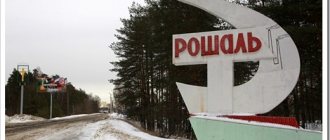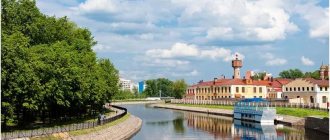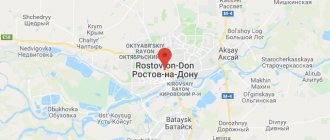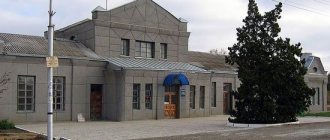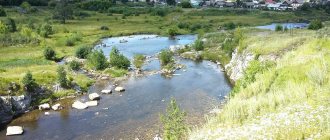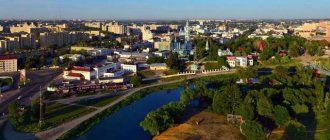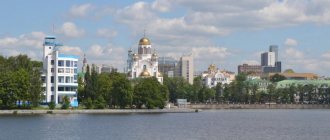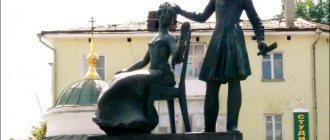There was a lot in the history of Lebedyan, an ancient Russian city that arose on the banks of the Quiet Don at the beginning of the 18th century. And defense from Tatar raids and Ukrainian Cossacks, and famous horse fairs, and horse racing at the local hippodrome, and the first trotting society in Russia. Merchants and townspeople, musicians and writers, poets, doctors, military men and locally revered saints wrote their names into the history of Lebedyan...
Writers Ivan Turgenev and Mikhail Bulgakov, artists Pyotr Sokolov and Boris Kustodiev also visited here. It smells of linden blossoms and delicious aromatic apples, there is wonderful fishing, picturesque nature and old architecture.
Lebedyan in the 17th century
The city arose on Tyapkina Mountain. It was first mentioned in 1605 under the name “Leedyan settlement”. Eight years later it turns into a defensive point of the southern borders. Before receiving city status in 1613, Lebedyan changed hands every now and then.
In the spring of 1613, a detachment of gultyaev-Cossacks came to the city under the leadership of the rebellious ataman Ivan Zarutsky, and five years later the city was ravaged by Hetman Sagaidachny, who marched with twenty thousand troops to help the Polish king.
Well, after each devastation, the city recovered, and life gradually got better. In 1621, a mile from the city, in the Yablonovy meadow of the Romantsov forest, the Holy Trinity Monastery was founded. At that time, the Lebedyan fortress, which stood on a high cliff above the Don and the Borodyanka River, consisted of a citadel (a small oak five-tower fort with a wooden cathedral in the name of St. Nicholas the Wonderworker) and all kinds of government buildings. Outside the walls of the fortress there were settlements and settlements of service people - Pushkarskaya, Streletskaya and Pokrovskaya. Each had a wooden church.
At that time, about 1,500 people lived in Lebedyan, most of whom were service people: Cossacks, archers and cannons. In addition to service, many of them were also engaged in trade or crafts. The household of an ordinary Lebedyan resident differed little from an ordinary peasant household: a hut, a bathhouse, outbuildings, and a threshing floor. They didn’t live richly, but they weren’t poor either. The farming was carried out practically on a subsistence basis: they sewed and made utensils themselves. The exceptions were gunpowder, ammunition and iron products - they, as a rule, were sent from Moscow.
And although the peaceful work of the Lebedyans was constantly interrupted by raids of nomads, they successfully coped with the task assigned to them: to protect the borders of the state from Tatar raids. The service people of the city tracked down the enemy in the steppe or learned about his arrival in a neighboring settlement. In the event of an enemy raid, the fortress city sheltered the district people with their families and property within its walls.
So, in August 1632, the Tatars, numbering 1000 people, divided into several detachments, began planting from all sides. The hot battle dragged on until the evening. With all their strength, the Lebedyans defeated the enemy.
In the second half of the 18th century, the defense line moved southeast of Lebedyan, and the city began to lose its military purpose. A relatively calm time began for the residents.
Menu
Archaeological finds on Tyapkina Mountain - the site of the construction of the Lebedyanskaya fortress - allow us to assert the existence of a Slavic settlement here back in the 8th-10th and 12th-13th centuries1. And legends also speak of an older age of the city than is generally believed, dating the construction of the first fortifications to the 14th century. Lebedyan, together with neighboring Yelets and Dankov, was not only a border city of the Ryazan principality and the border of the Russian state, but also a place through which the trade route to the states of the Black Sea coast passed. The first surviving written mention of Lebedyan dates back to the beginning of the 17th century. It is known that Lebedyan or the village of Lebedyanskoye fortified settlement existed in 1605 and belonged to the Moscow nobleman Nikita Dmitrievich Velyaminov as an estate. It cannot be ruled out that this estate appeared at the end of the 16th century under the Russian tsars: Fyodor Ivanovich or Boris Godunov. During the Time of Troubles, the Lebedyan settlement passed from hand to hand. Only after October 1612 did Lebedyan cease to be a proprietary settlement2. Tatar parishes from beyond Voronezhi to the Don revealed the need to build a new city between Dankov and Yelets. The fortified Lebedyansky fort was the best suited for this task. A military garrison consisting of archers and Cossacks was sent here, who began to equip the fortress. There was little time allotted for this. In the spring of 1613, a detachment of Gultyaev-Cossacks led by Ivan Zarutsky arrived under the city walls. Departing from Moscow, the rebellious ataman tried to take possession of Livny, but, not taking the city, retreated to Lebedyan. At the same time, governor Ivan Odoevsky was sent from the capital, reporting to Moscow that Zarutsky “stands on Lebedyan and hunts over him”3. Having united with other forces that approached, Odoevsky forced the Cossack chieftain to leave Lebedyan. In 1613/14, Lebedyan received its first governor, Lavrenty Aleksandrovich Kologrivov, and became a city. Having arisen on the basis of the southern lands of the Dankovsky district, Lebedyan between 1616 and 1618/19 received the lands of the Ryazhsky district on the river. Voronezh2. In 1615, Nikita Somov became governor. However, the city did not have to serve the sovereign for long: in 1618, Lebedyan suffered a difficult ordeal. To help the Polish king Vladislav, who was going to gain the Muscovite kingdom for himself, the Little Russian hetman Sagaidachny moved to Russian cities with his 20,000-strong army. When the hetman took Yelets, the Lebedyansky governor Semyon Leontyev, not hoping to sit out the siege, left the city. Sagaidachny devastated the city “completely”: the fortifications were destroyed, the settlements and settlements were burned, the residents fled or were taken prisoner. After its destruction, the residents did not want to return to their previous place of residence. The government searched for them throughout the district and forcibly removed them. The city felt the consequences of Sagaidachny’s raid for a long time and recovered slowly4. The troubled time passed, and life began to improve. In 1621, a mile from the city, on the Yablonovaya glade of the Romantsov forest, by order of Patriarch Filaret, former boyar Fyodor Nikitich Romanov, the Holy Trinity Monastery was founded. Surrounded by a high stone wall with loopholes, it was an almost impregnable fortress. In the 17th century, he was called the patriarchal brownie, and the patriarchs generously presented him with money and lands. Significant field and forest lands, villages and hamlets of the district become the property of the monastery5. The city was also rebuilt. In 1627, in Lebedyan there was a “small oak fort” - 50 fathoms long and 30 fathoms wide. It had five towers, two of which were roadways and a hiding place to the Don. In the fort there were: the Cathedral Church in the name of St. Nicholas the Wonderworker "wooden dumplings" and government buildings: a moving hut, a governor's hut with a courtyard, a prison, a cellar with military supplies - gunpowder, cannonballs and arquebuses, a granary with the sovereign's grain. The small fort was located on a high mountain on the right bank of the Don, and occupied its corner. On this side, nature gave the city good natural protection in the form of two steep cliffs to the Don and the river. Gorodenka. This was the citadel of the city. There were no natural barriers on the Crimean side, so a “large oak fort” was required. It was 200 fathoms long and ran in a semicircle, adjoining the small fort at two points. Of the seven towers of the large fort, three were passable. Behind the fort there was a small settlement and adjacent settlements of service people: Streletskaya, Pokrovskaya and Pushkarskaya. Each settlement had its own wooden church. At this time, there were 266 individual householders in the city and settlements, and about 1,500 people lived4. But peaceful work was constantly interrupted by raids of nomads. So, according to the Lebedyan governor Ivan Skornyakov-Pisarev, in August 1632, the Tatars, numbering a thousand people, divided into several detachments, began planting from all sides. A hot battle ensued, lasting until Vespers. With all their strength, the Lebedyanites defeated the enemy, “they repulsed the military people of the Tatars from the settlement and did not allow them to burn the settlements...”. Lebedyan successfully coped with the task assigned to her - to protect the borders of the state from Tatar raids. This general goal of “conservation” included a number of tasks for the defense of the region. The city's servicemen were obliged to track down the enemy in the steppe or find out about his arrival in a neighboring settlement. In the event of an enemy raid on the city, the fortress sheltered the district people with their families and property within its walls. Almost all the interests of its population were subordinated to the city's defense service, which left a unique imprint on human life. The overwhelming majority of the city's population consisted of service people: Cossacks, archers and gunners. The city walls were constantly strengthened, the ditches were deepened, and the gouges and slingshots were restored6. In 1646, Lebedyan became the base for preparing the campaign of Moscow troops against Azov. Here, on the Krasivaya Mecha River not far from the city, under the supervision of the Voronezh official V. Strukov, they begin to build ships. By September 1646, 100 plows had been built, which, having broken into groups, reached the Don, headed for Azov. Below they were joined by 20 ships from the sovereign's tax-paying troops and 10 plows from the estates of boyar I.N. Romanov and Prince A.N. Trubetskoy from Lebedyansky district. But not everyone was destined to take part in hostilities. Due to the storm, some of the ships sank. But others came after them. Failures did not stop the shipbuilders. In the 1660s, sea expeditions continued. Ships from Lebedyansky shipyards also took part in them7. In the second half of the 17th century, the city gradually lost its military purpose. The defense line lies southeast of Lebedyan. The new fortresses of the Belgorod abatis line now protect Lebedyan from Tatar raids. A comparatively calmer time begins for residents. In 1662, the Lebedyanskaya fortress was rebuilt: the city and the large fort were united into one fortification - the city. Lebedyan is expanding and beautifying. Trade is developing here and the area is growing. New settlements appear: Kuznetskaya and Krasnaya (later Kuznetskaya and Krasnoslobodskaya streets). The temple in the name of the Wonderworker Nicholas is expanded and renamed the Kazan Cathedral Church. A stone church in the name of the Nativity of the Virgin Mary is being built. In 1692, the Preobrazhensky Krasnogorsk Maiden Monastery was built on the banks of the Don. Years passed. In 1703, the wooden fort burned down and was never built again4. The defensive life of the city is over. Lebedyan becomes the center of commercial, industrial and cultural life of the region. Its successful location: at the intersection of the “bolshakov”, at the junction of five provinces - Tambov, Voronezh, Ryazan, Oryol and Tula, as well as the rich traditions of holding fairs very early allowed Lebedyan to stand on a par with the largest trading cities of Russia. The Lebedyansky fairs, which gained all-Russian fame by the end of the 17th century, were started by large bazaars, which were held on church holidays during the gathering of pilgrims. From time immemorial, such bazaars took place in Lebedyan on Trinity Day (May-June), on the Feast of the Intercession (October 1, Old Art.), on the Day of Transfiguration (August 6, Old Art.) and on the Feast of Epiphany (January 6, Old Art.) . The fairs that took place not only enlivened the life of Lebedyan residents, but also brought significant profits to the city. The main occupation of the townspeople were various types of crafts and trade. In addition, city residents received great benefits from renting out their houses. During the fairs, few houses were not occupied by guests. Many of the homeowners, especially near the Fairgrounds, lived only on the money they received from providing housing for visitors and from the sale of horses brought to the fairs. Ranking fourth in the country in terms of sales in the mid-19th century. Lebedyanskie fairs with their taverns, merchants, gypsy choirs, and horses attracted guests from all over the country three times a year. The Epiphany and Pokrovskaya fairs lasted for a month, and the Trinity fair lasted 6 days. It was in Lebedyan that the first hippodrome in Russia was built, and in 1826 horse lovers from all over Russia united here. The first official horse races with a program, judging and prizes were held in Lebedyan on September 19, 1825. It was their success among experts that led to the idea of creating a racing society. Soon its charter was drawn up, after approval by the emperor, approved by the provincial administration. The founders were people known throughout Russia: prominent horse breeders and horse connoisseurs. In the fall of 1827, the first meeting took place. The Lebedyansk Racing Society was the first in Russia and the only one at that time to deal with issues of horse breeding and breeding. Society meetings and races were held annually during the Intercession Fair and lasted more than a week. On the left low bank of the Don, a hippodrome was built, which was shaped like a square with smooth angular turns and turns and a length of about two miles. At the finish line on the southern side of the “circle,” there were galleries for spectators. A prize pole and flagpole were installed nearby. The judges were also here. In 1832, the Lebedyansk Racing Society introduced trotting horses into the program of racing competitions. As before, only highly purebred horses with a known pedigree, specially selected for competitions, took part in the races. And there were plenty of people willing to show their horses: horse breeders from neighboring provinces and the capital had long ago chosen Lebedyan for their annual meetings. Local landowners were also famous for their horses. But not only horses were traded at the fair. The main items of trade were also leather, Siberian furs, bread, wood products brought from the northern part of the Tambov province, haberdashery and red goods delivered from Moscow, Orel, Yelets, wax, candles, lard, soap from Kharkov, Kursk, Poltava merchants and other goods of industrialists and landowners of adjacent provinces. Since 1845, regular exhibitions of “rural products” have been held at Lebedyan fairs, which marked the beginning of the creation of the oldest Lebedyan Agricultural Society in Russia - the cradle of the main reform projects of 1861. During its existence from 1847 to 1862, the society left a noticeable mark on the history of agronomic science in the country. Through the efforts of members of the society and especially its president, the Dankovsky landowner and famous scientist N.P. Shishkov's society became the center for collecting and disseminating agronomic knowledge and experience in the region. The published journal “Notes of the Lebedyansky Society of Agriculture” (a total of 22 volumes were published) contains large and valuable material on all branches of agriculture in relation to the conditions of our region. Many of the society’s proposals have not lost interest in our time, and some innovations were ahead of their time and were recognized only a century later9. In the second half of the 19th century, the city of Lebedyan reached its peak. At this time, many beautiful buildings were being built here: a men's gymnasium, the City Duma and the Zemsky Assembly, and the construction of Trading Rows with merchant shops was being completed. A two-story corner house of the merchant Proskurnin10 was specially purchased for the zemstvo hospital. The city center is decorated with new and architecturally interesting two-story merchant mansions. According to a contemporary description, “the city, occupying a picturesque location on a mountain, has very wide and long streets. There are seven Orthodox churches and the Trinity Monastery here.” Of the churches, the New Kazan Cathedral attracts attention, “both for its architecture and size,” as well as three stone parish churches of “very ancient architecture”11. However, in 1892, a railway was laid through Lebedyan, which, along with the beginning of a drop in bread prices, contributed to a sharp slowdown in the development of the city. And although the Lebedyan horse fairs at the beginning of the twentieth century continued to be an important event in the life of the city, they were now only memories of the scale that they had half a century ago. In 1902, 2860 horses were brought for sale to three Lebedyansk horse fairs, of which 2400 were sold. The turnover amounted to 121,000 rubles12. At the beginning of the twentieth century, the economic situation nevertheless stabilized. The city's increased income allows for its improvement. It was at this time that a new reinforced concrete bridge was built across the Don (1910), two artesian wells (1914) for the city’s water supply, streets were paved, and linden trees were planted on the central Dvoryanskaya Street. The cultural life of the city is also reviving. To the city theater, which staged its performances in the Zemstvo building, cinematographs were added - “Illusion” by E. Epstein and “Electrotheater” by E. Yakovlev13. First, a telephone network is laid in the city, and then in the county14. The network of educational institutions is expanding. At this time, there were five parish schools, a men's gymnasium, a city four-year school, men's and women's parish schools, and a private women's four-year pro-gymnasium in Lebedyan. Time flows and many things change in Russia over the years. Since 1928, Lebedyan has become the center of the region, part of the Yeletsk district, first of the Central Black Earth Region, then of the Voronezh Region, and then of the Ryazan Region. Since January 1954, Lebedyan has been part of the newly formed Lipetsk region. Machine-building, tool, fruit and berry factories, and a construction and finishing machinery plant are being built in the city. New apartment buildings are appearing. The Don banks are connected by a new reinforced concrete bridge, and a new bus and railway station is being built. However, its attractive features, which appeared back in the 18th-19th centuries. Lebedyan retains it for now. Even at the beginning of the 21st century, the city remains a classic merchant and provincial city. Its architecture is in amazing harmony with the environment and creates a feeling of comfort. The central street of the city, Sovetskaya, formerly Dvoryanskaya, is a wide straight street with merchant and bourgeois houses and rows of old linden trees on both sides. The trees were carefully planted in 1910 and still delight citizens and guests of the city with the summer coolness and fragrant linden aroma in June. In the center of the city, many interesting one-story and two-story merchant estates have been preserved, forming a single whole with stone entrances and outbuildings. In terms of its architecture, the complex of Trade Rows, encircling the Bazarnaya Square block on four sides, houses the following buildings: the City Duma, the men's gymnasium, and the zemstvo hospital. Houses of Igumnov, Durasov, Neronov. One of the distinctive features of Lebedyan’s architecture and its indisputable advantage remains, as before, the balconies of one-story houses facing directly onto the roadway. Once they decorated almost every city estate and you can easily imagine how on summer evenings the townspeople sat on their balconies, drinking tea from bucket samovars. Despite the destruction of the atheistic era, five churches have survived in Lebedyan. They are all different in architecture, but beautiful in their own way. The Old Kazan Cathedral (built in 1771) is located on the site of a wooden fortress and marks the oldest part of the city; the Church of the Nativity of the Virgin Mary (second quarter of the 18th century) stands near the mass grave of the city’s defenders from the Mongol-Tatar conquerors; Novo-Kazan Cathedral (1836) is the central, largest and most beautiful temple of Lebedyan. Its almost 60-meter bell tower pierces the heights with its spire, gently blue walls with white decor are in harmony with the blue of the sky, and five chapters sparkle with silver in the sun. The cathedral, visible from all around, along with the old State Bridge, is rightfully considered a symbol of the city. Lebedyansk land has always been famous for its talented people. Here is the birthplace of People's Artist of the USSR K.N. Igumnov, a prominent figure in domestic healthcare S.N. Igumnov, professor, Soviet art critic N. Kozhin, artist, secretary L.N. Tolstoy - Yu.I. Igumnova, Soviet inventor, film equipment designer V. Konstantinov, 2nd avant-garde artist V. Sitnikov, international journalist, artist N. Sitnikov, world-famous epidemiologist A.A. Churilina, poets and writers T. Churilin, E. Zamyatin, A. Levitov, N. Pogodin, Honored Artist of the BSSR B.V. Nikolsky, professor, founder of higher conducting choral education N.V. Romanovsky, sculptor, member of the Union of Artists V.I. Morozova. A full member of the Russian Geographical Society, historian, local historian, one of the organizers and the first director of the museum of the city of P.N. lived most of his life in Lebedyani. Chermensky. L.N. Tolstoy, M.N. Zagoskin, A.D. Kopyev, A.N. Ostrovsky, S.P. Zhikharev, A.V. Koltsov, M.M. Prishvin. I.S. Turgenev and artist P.P. Sokolov, here wrote his Don Quixote M.A. Bulgakov, created the picturesque canvases of B. Kustodiev. Andrei Bely, who spent a honeymoon in the city, wrote: "Swan is beautiful!" Unusual grace is filled with the air of the Lebedes, many fellow countrymen note. Perhaps because this land gave the world several holy people: Siluana Athos, Illarion Troekurovsky, John Szenovsky ... And the Sesenovsky Convent, built on the initiative of St. John, was a pearl of monastic architecture in Russia15.
As for the name of the city, it is quite easy to explain. In those ancient years, when the city was just a wooden fortress with suburbs around it, the great Swan Lake was located to the west of it16. Flocks of snow-white birds took off from it and circled over the city. When in 1779, by decree of Catherine II, the city was granted a coat of arms, a swan appeared on it. Now there is no lake. In its place are fields and gardens of suburban farming, and a small pond that does not dry out even on the hottest summer days. But a little away from the city, on the Beautiful Sword, graceful swans can be observed regularly, even with offspring. So, a couple of years ago, in the fall, when thin ice had already formed on the river during a frosty night, a flock of snow-white swans descended onto the wormwood without fear. Having fed and tumbled in the water, at sunset the birds, spreading their wings, powerfully and amicably broke away from the water surface, heading upstream towards the forest... leaving behind a city called Lebedyan17.
Valery Akimov
A source of information
1. Klokov A.Yu. Lebedyan. Legends and realities. // Notes of the Lipetsk Regional Local Lore Society. Issue IV. Moscow-Lipetsk 2005 2. Gamayunov A.I. About Lebedyan - a village, a city and a county center // Social history of the Russian province in the context of the modernization of agrarian society in the 18th-19th centuries. Proceedings of the international conference. Tambov, 2002, p. 244-256 3. Palace categories vol. 1 St. Petersburg, 1850 pp. 92-93 4. Chermensky P.N. “The city of Lebedyan and its district in the 17th century” St. Petersburg 1913 5. Kolaisovsky N. Lebedyansky Trinity Monastery. // Tambov Diocesan Gazette. Tambov. 09/25/1875 6. Chermensky P.N. History of Lebedyan. Manuscript. 1968 7. Vetlovsky I. Lebedyanskie shipbuilders // Lebedyanskie Vesti 1996 8. Zhikharev S.P. Lebedyansky races of 1841. // Northern Bee No. 11, 1841. 9. Popov B.P. Society of Agriculture in Lebedyan. Notes of the Lipetsk Regional Local Lore Society. Issue I. 10. Popov B.P. The story of one house // The Path of October. 11. Geographical and statistical dictionary of the Russian Empire P.P. Semenov, 1863-1885 vol. 3 12. Collection-calendar of the Tambov province for 1903. Tambov, 1903. 13. Akimov V.V. How cinema came to Lebedyan // Lebedyanskie Vesti. 10, 17, 24.08.2002 14. Akimov V.V. Telephone in Lebedyan // Lebedyanskie Vesti 08.20.2002 15. From the history of our region // Lebedyanskie Vesti No. 47, April 15, 2003 16. Report of the Lebedyansky governor I.A. Domogatsky. 1709 17. Akimov V.S. Swan land // Lebedyanskie news No. 134, 6.11.2001
Lebedyan in the 18th century
In the era of Peter the Great, the city entered as a trade and craft Posad, while still retaining the functions of a military service city. Finding herself on the way from Moscow to Voronezh, where the construction of the Russian fleet was underway, Lebedyan was involved in the turbulent events of that period. The Lebedyans took part in the Azov campaigns: they built plows and, as part of Sheremetyev’s auxiliary army, stormed fortified Turkish towns and the mouth of the Dnieper, reaching Ochakovo.
The Streletsky uprising of 1698 also left its mark on the history of the city. After the defeat of the Streltsy, more than fifty exiles were sent to Lebedyan. These were former archers from Chernov's regiment. Some of them were executed here.
In 1703, the wooden fort burned down and was never built again. And although during the days of the Bulavinsky uprising of 1708 Lebedyan was one of the points of concentration of government troops, the military and defensive life of the city ended.
The city becomes the center of commercial, industrial and cultural life of the region, ranking on a par with the largest trading cities in Russia. The development of the local fair culture was greatly facilitated by its favorable location: at the junction of the provinces of Tambov, Voronezh, Ryazan, Oryol and Tula.
The growth of prosperity could not but affect the growth of the city. It is likely that the remains of the earthworks were hidden at the turn of the century. The territory of the city fortress began to be built up with philistine houses.
In 1788, a new general plan for Lebedyan was drawn up, which envisaged replacing the previous chaotic development with a regular layout with a clear breakdown into blocks. Large-scale transformations in accordance with the approved plan became possible after the approval of the general plan in St. Petersburg in 1806. And especially after the big fire in the summer of 1813, which destroyed almost the entire center of Lebedyan.
Office building - Attractions | Lebedyan
Office building (city magistrate) (Lenin Square)
Public offices building (city magistrate) (Lenin Square). Photo by L.M. Krapivina.
The prison in Lebedyan has existed since the founding of the city. In the description of the Lebedyansky fort, among other buildings, there is a mention: “... a hut and a voivodskaya hut and a hiding place, and near the hiding place there is a prison.” Over the years, the location of the prison has changed. In the 1780s. it was also a “prison hut” located on the territory of a former prison. The old historical buildings were in their last years. After 1815, when almost the entire city burned down as a result of a large fire, it was decided to build a new city prison.
There is reason to believe that the Prison Castle (also known as the government building) in Lebedyan was built according to the design of the architect Visconti, confirmed and recommended for use in other county towns. After the Decembrist uprising, the changed situation required the reconstruction of the Prison Castle. In 1830, reconstruction was carried out and a fence wall was built. Being a functional building, however, like most buildings of the early 19th century, the Prison Castle had decorative design and elements that adorned this originally government building.
(From the book by V. Akimov “Lebedyan from A to Z” (Lebedyan, 2022)
www.lebedyan.com
19th century
The first half of the 19th century can rightfully be considered Lebedyan’s “golden age”. Four annual fairs (Epiphany, Troitskaya, Pokrovskaya and Preobrazhenskaya) turned the city into one of the main Russian fair centers. Ranking fourth in the country in terms of sales in the mid-19th century, Lebedyansky fairs with their taverns, merchants, gypsy choirs, horses, attracted guests from all over the country, and brought significant income to the city and its residents.
Horse lovers came here from all over Russia. In September 1825, they held the first official races here with a program, judging and prizes, and a year later they founded the first racing society in Russia. The founders were well-known horse breeders and horse connoisseurs throughout Russia. From now on, during the Intercession Fair in Lebedyan, they held a meeting of the society and horse races, for which a hippodrome was built on the low left bank of the Don. Only highly purebred horses with a known pedigree, specially selected for competitions, took part in the races. And there were plenty of people willing to show their horses.
In 1845, regular exhibitions of rural products began to be held at the Lebedyansky fairs, which laid the foundation for the creation of the oldest agricultural society in Russia. During its existence from 1847 to 1862, it left a noticeable mark on the history of economic science in the country. In the mid-1850s, there were 63 stone and about 500 wooden houses, 98 hotels, 70 kirs, and 11 taverns in the city.
In the second half of the 19th century, Lebedyan reached its peak. At this time, many beautiful buildings are being built here, and the construction of shopping arcades is being completed. The two-story corner house of the merchant Proskurin was specially purchased for the zemstvo hospital. However, growth gives way to decline. With the start of railway construction, fair trade declined sharply. All this, along with the beginning of a fall in bread prices, contributes to a sharp slowdown in the development of the city.
The city of Lebedyan is the apple capital of Russia
You open the window and you are simply enveloped by the smell of fresh apples. Not fumes, gasoline, chemical plants, but apples. This is the only and amazing place - the city of Lebedyan. In the city of apples we found ourselves in the “apple rescue”.
It is said and shown about Lebedyan on the Internet. Most of our time there was rainy, foggy and at night, so we didn't get any good photos. And that’s why I want to share my impressions of the city, illustrating them a little.
Lebedyan. Market and Kazan Cathedral. 08/19/2012
Lebedyan
, in my opinion,
one of the most complete and balanced small cities in Russia
.
Harmony both externally and internally.
The city is not far away (from Lipetsk 70 km, from Moscow 370 km) and not so close that large cities would suppress it. The Don federal highway is nearby (40 km), but the city is off to the side, which eliminates unnecessary transit. There is a railway with passenger service, but again not a main line. There is a beautiful river, but without navigation.
Inside the city is also balanced.
And its terrain is flat and there are hills that provide variety. Lots of viewpoints. There is the Don River, a well-known river, but in the city it has a good size of 50 meters wide and you can swim, but it does not divide both banks into different worlds.
The climate is wonderful. The soils around are chernozem. The city is surrounded by gardens.
And the city itself. Not big, but varied. There is a historical merchant center, there are Soviet microdistricts, there are industrial zones, there are picturesque settlements and nearby villages, there is a railway, but it does not cut into the city. Given the sufficient spaciousness of the city, there are no significant breaks in the urban fabric. And there is no pronounced dominance of large neighborhoods or the private sector.
The city has quite a decent 400-year history. In 1605 it was mentioned as a fortress. In 1779, it was granted its own coat of arms with a swan. The swan is an important Russian symbolic bird, and on the coat of arms of only one city in the country (I might be wrong).
The center is the center. And there are outskirts. The main and undisputed dominant is the bell tower of the Kazan Cathedral. The city center is nice and solid - there is a large cathedral with a bell tower. There are several smaller temples. And in the churches of the city there were a lot of people at Sunday services, much more than in our tourist Transfiguration Cathedral. There are shopping arcades around the cathedral. Moderately beautiful, but very alive. Nearby is a pedestrian street. All two blocks, but with old houses, an illuminated fountain and benches. A pleasant place for an evening promenade. City services and organizations are located right there in the old mansions. There is a small but neat park nearby. And overall clean and tidy. And almost no Soviet faceless buildings. Only a large classical palace of culture on the square in front of Ilyich. It stands well on the high bank of the Don. It's just a pity that the bank is overgrown.
The center is gradually getting better. Looking at photos of the city over the past five years, a definite improvement can be seen. Buildings are being repaired and painted.
Lebedyan. St. Mira. 08/18/2012 Lebedyan. Fountain on the street Mira. 08/19/2012 Lebedyan. In the Kazan Cathedral. 08/19/2012 Lebedyan. On the street Mira. 08/19/2012 Lebedyan. St. Soviet. 08/18/2012
There are settlements - almost rural streets with large vegetable gardens, spaciously spread along the banks of the Don.
The city also has a spiritual center - the Trinity Monastery (1621 or 1628). One of the oldest in the Lipetsk region. Quiet, peaceful place on the city outskirts. With two ancient cathedrals, buildings and a stone wall-fence, with a cozy square and lots of flowers. And also interesting mosaics on the temple and entrance gate.
Lebedyan. Holy Trinity Monastery. Mosaic at the entrance. 08/19/2012 Lebedyan. Trinity Cathedral (1666) and Assumption (1621) Church. 08/19/2012 Lebedyan. In the Trinity Monastery. 08/19/2012 Lebednyan. Trinity Cathedral. 08/19/2012 Lebedyan. Swans at the entrance to the Trinity Cathedral. 08/19/2012 Lebedyan. Ornate votoros of the Trinity Monastery. 08/19/2012
There are also cultural centers - a museum, a palace of culture, a gymnasium, and three schools.
There is also a diverse living industry. In addition to the giant juice plant, on different city outskirts there are factories for the production of corrugated materials (Assol), spare parts for LeMaZ tractors, dairy products, construction equipment (concrete mixers, etc.) Stroymash). Everything is very necessary and purely creative.
Lebedyan. The main entrance of JSC Lebedyansky. 08/19/2012
There is a decent hotel at the juice factory and a good cafe “Rush Hour”.
There is a cult figure - Leonid Mulyarchik - the lonely builder of the first line of the Lebedyansky metro, alas, already deceased. Yes, the man wanted and began to build a metro. I, too, once dreamed of a metro in Georgievsk.
There is money in the city. Apparently the enterprises are working. The cars are quite decent. Although Lebedyan is not rich. And in general, it somewhat resembles the calm Ukrainian cities of Slobozhanshchina.
Charged with this balance and inner wealth of the city, I want to convey it to the outside world and convince the local population of it. You want to invest in such cities, but you also understand that they themselves are capable of rethinking themselves.
What a wonderful selection of books about the city and the phenomenon itself of an encyclopedia of the city based on Wikipedia https://lebedyan.rf/ (of the successful projects of small cities, I only know WikiZybkov, about Novozybkov and the not entirely successful encyclopedia of Dzerzhinsky). How many people have written about the city. Honestly, I’m surprised by so many local historians. There is also a good diagram of the historical and cultural heritage of the quarter around the Kazan Cathedral. Just why these books are actually not on sale. There is no sign saying that there is something to read and learn about our city. At the kiosks, when I ask for a map of the city, they give me a map of Lipetsk. Lipetsk is much less interesting than Lebedyan.
Source
XX century
Lebedyan began to emerge from economic stagnation at the turn of the 19th-20th centuries. At the beginning of the century, there were 2 tanneries and two soap factories, a distillery, a candle and tallow factory and several pottery workshops in the city. The main income of the Lebedyan residents came from grain trade.
In 1906, city public transport was provided by cab drivers, the demand for which increased markedly with the construction of a railway station remote from the city.
The increased income of the city again made it possible to begin its improvement. At this time, a new reinforced concrete bridge was built across the Don, along with two artesian wells for water supply.
Population
| Population | ||||||
| 1856[13] | 1897[13] | 1913[13] | 1931[13] | 1959[14] | 1970[15] | 1979[16] |
| 5000 | ↗12 800 | ↗16 000 | ↘11 100 | ↘8595 | ↗12 298 | ↗20 006 |
| 1989[17] | 1992[13] | 1996[13] | 1998[13] | 2001[13] | 2002[18] | 2003[13] |
| ↗22 850 | ↗23 100 | ↘22 600 | ↘22 200 | ↘21 300 | ↗22 966 | ↗23 000 |
| 2005[13] | 2006[13] | 2007[13] | 2009[19] | 2010[20] | 2011[21] | 2012[22] |
| ↘22 000 | ↘21 600 | ↘21 200 | ↘20 713 | ↗21 012 | ↘20 949 | ↘20 724 |
| 2013[23] | 2014[24] | 2015[25] | 2016[26] | 2017[2] | ||
| ↘20 478 | ↘20 241 | ↘20 117 | ↘19 866 | ↘19 503 | ||
Soviet time
Since 1928, Lebedyan has become the center of the region, part of the Yeletsk district, first of the Central Black Earth, then of the Voronezh, and then of the Ryazan region. Since January 1954, the city has been part of the newly formed Lipetsk region.
Factories are being built, streets are being improved. Instead of paving stones, asphalt pavement is laid. In July 1950, a water supply system started operating in Lebedyan, built by local residents using the “people’s construction” method. This first branch, stretching along the odd side of the central Sovetskaya Street from the upper water pump on the edge of the former Fair Square, gave the townspeople free drinking water.
Lebedyan today
Today the city is home to more than 20 thousand residents. There are three secondary educational schools, 7 kindergartens, a preschool correctional orphanage, two music schools, a children's and youth center, and a sports school.
Despite the industrial development and housing construction of the last hundred years, Lebedyan still retains the attractive features that appeared in the 19th century. In the central part, the city remains classic merchant and provincial, its architecture is in harmony with the environment and creates a feeling of comfort.
Attractions
In the center of the city, one- and two-story merchant estates with stone entrances and outbuildings, a complex of Trade Rows encircling the Market Square quarter on four sides, the building of the City Duma, a men's gymnasium and a noble assembly have been preserved. Built in 1910, the reinforced concrete bridge across the Don River has long represented an advanced achievement of technical thought and was the largest reinforced concrete bridge in the region.
One of the famous places is Tyapkina Gora
. According to one legend, the Cossack robber Tyapka lived there, who robbed ships sailing past along the Don. On the mountain is the central part of the city, which includes the historical center with most of the attractions and public institutions.
The following have also survived to this day:
The city has a local history museum and a House of Crafts, where paintings by local amateur artists and products by craftsmen are exhibited.
15 km east of Lebedyan is the village of Shovskoye - the birthplace of the Monk Silouan of Athos. In the vicinity of the city there are two monasteries, Sezenovsky Ioannovsky and Troekurovsky Ilarionovsky. Both monasteries are currently active and are being restored with the support of philanthropists and local farms.
Metropolitan
From 1989 to 2011, construction of a private metro line was carried out in Lebedyan. The construction was led by retired enthusiast Leonid Vladimirovich Mulyarchik. As of 2009, the length of the existing tunnel is about 200 meters. The reliability and strength of the structure has been confirmed by experts[28].
The construction was repeatedly covered by all-Russian television channels, print media and Internet sites[28][29][30][31].
Some experts question the fact that the excavation work was carried out by Mularczyk himself. According to Yuri Pervitsky, a researcher at the Lebedyansky Museum of Local Lore, “there are many underground passages under Lebedyan. Galleries are sometimes three or four stories high, lined with stone. And it is quite possible that our famous fellow countryman ended up on one of the secret passages.”[28]. Also, Mularczyk’s activities aroused disapproval from other city residents[28].
L.V. Mulyarchik died in the winter of 2012, the city authorities filled up the mine.
